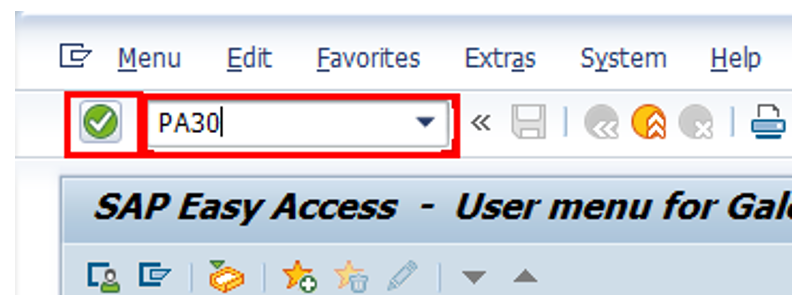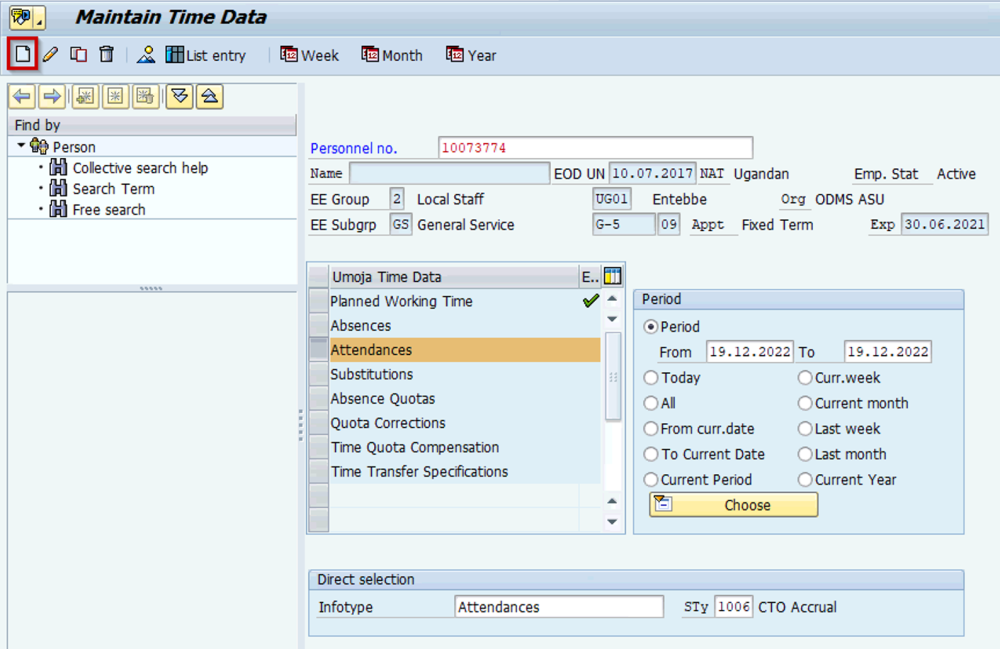Review This

Time evaluation runs on a daily basis at the end of the day.
- Should only be used in cases where the staff member and time administrator do not have access to ESS and are unable to record entries.Start the transaction using the menu path or transaction code.
- Click
after typing PA30 in the Command text box.
- Enter
- the staff member’s personnel number,
- the from and to dates of the attendance and
- 2002 in the Infotype text box.
- Click
to continue.
- Click
to display the list of options for STy.
- Select the appropriate attendance type.
- Click
to confirm selection.
This is the full list of attendance types that have to be chosen from.
- Attendance (WAE) – used for WAE contracts. Attendance has to be entered for every day that the WAE staff will be paid (you can use a date range for this entry). Note that staff member needs to be in the 7DAYWAE work schedule (Infotype 0007) in order for all entries to be paid regardless of whether it is a weekend.
- Attendance (compressed) – used to record the “extra” hours that the staff member works on a compressed work schedule (normally 10 in 9). By adding the attendance on these days, a quota called compressed regular day off will be generated and it will allow the staff member to request the 10th day off once enough extra hours have been accrued.
- Overtime (1.0) – used when you are recording overtime that has to be processed with a 1.0 payment factor
- Overtime (1.5) – used when you are recording overtime that has to be processed with a 1.5 payment factor
- Overtime (2.0) – used when you are recording overtime that has to be processed with a 2.0 payment factor
- CTO accrual – This entry is used to create a compensatory time off quota. As in the case of attendance (compressed), once enough CTO hours have been accrued, the staff member will be able to charge leave to this quota.
- Official business – This entry is used to record the time worked away from the office as official business.
This is the full list of attendance types that have to be chosen from.
- Telecommuting – used to record the time worked away from the office approved as telecommuting
- Stand-by/On call – used to record the time that a staff member has been required to block time to be on stand-by or on-call
- Weekend Premium – used to record the time that a staff member in Geneva with weekend premium schedule has worked
- Night Differential – used to record night differential for staff who do not have automatic night differential based on work schedule
- No danger pay – used to record the days that a staff member in a danger pay location has been absent from the duty station that triggers the danger pay. If you choose this option, the danger pay for the days you enter will be deducted.
- MSA override – used to override the MSA rate
- No MSA – used to record the days that the non-staff will have to have MSA deducted.
- Daily Cnf Lng-Addt’l Days – used for conference language staff paid on a daily rate who work on weekends. As conference language staff are paid based on a 5 day/week schedule, this option is to be chosen to record time worked on a weekend and to ensure payment.
- Click
to create the attendance record.
- Enter the starting and ending hours of the attendance.
You can use a non-24 hour format, i.e. 5:00 to 6:00 or 17;00 18:00. Clickto validate entries.
- Press F9 to add a note.
- The contents of the note should contain:
Attendance/Absence record created for s/m for < enter reason for record > for the period of < enter date(s) >. Email from approving manager, < enter name/title >, dated < date > refers.
- Click
to save the note.
- Click
again to save the record.
- Click
to exit the action and return to the SAP Easy Access screen.
)footnote1
Last modified:
20 February 2023






 to create the attendance record.
to create the attendance record.

 to save the note.
to save the note. to exit the action and return to the
to exit the action and return to the
Post your comment on this topic.